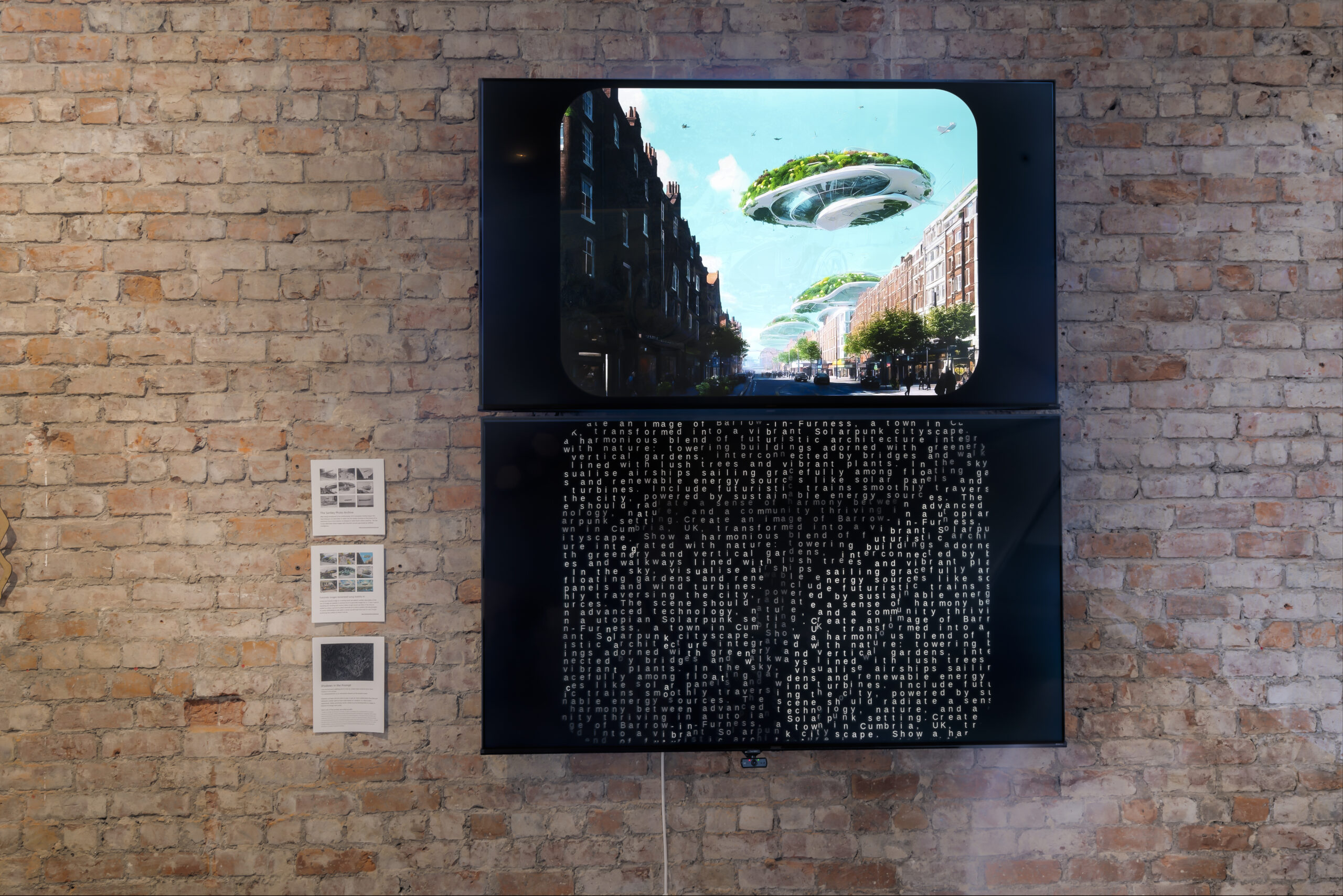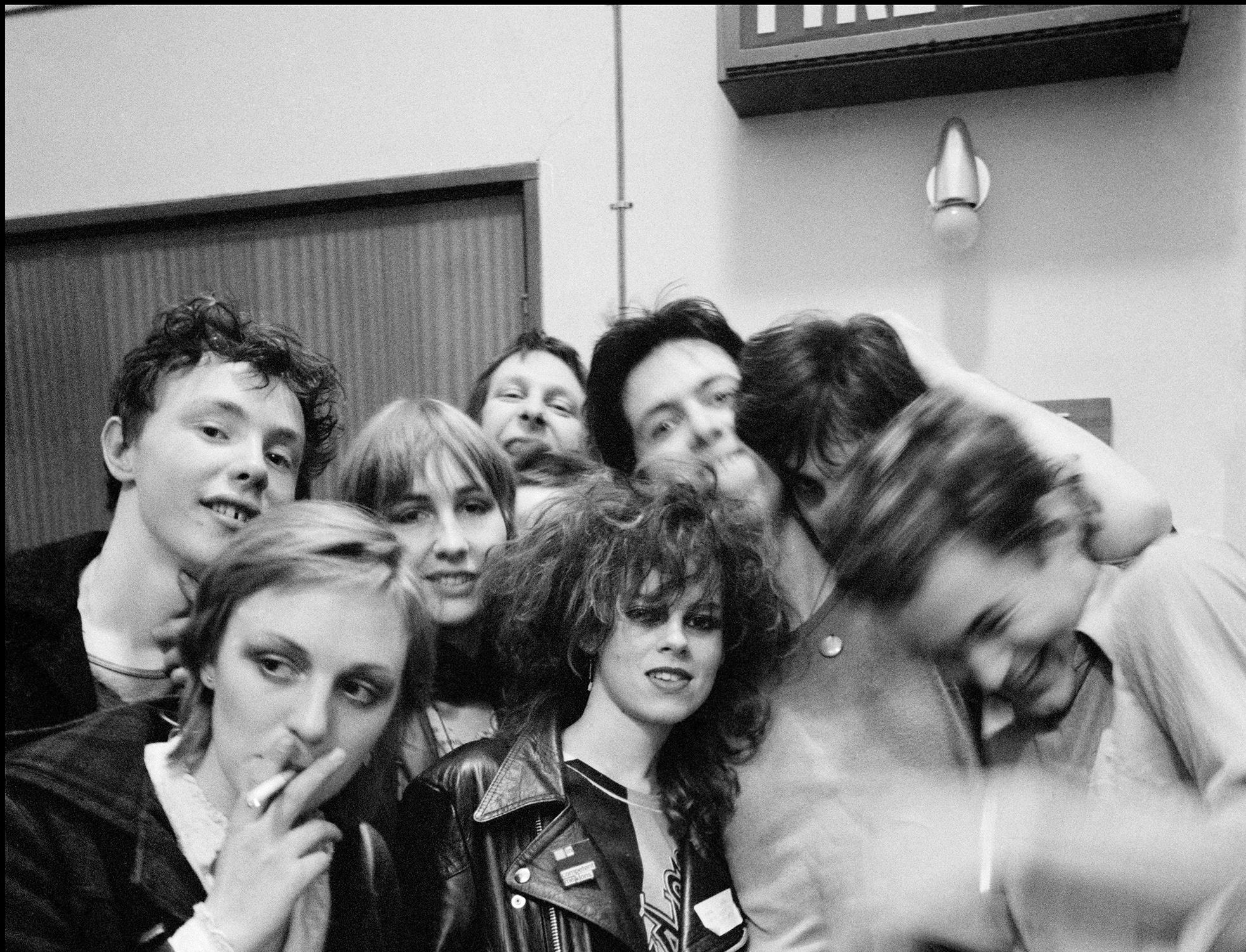‘An adventure in an optimistic future’ is the catchline Signal Film & Media are using to promote Relax into 2050, an interactive exhibition by Artfly exploring Barrow’s coastal environment and the future. It is one of this year’s series of TIDAL commissions managed by Signal Co-Director, Loren Slater. Arriving after a challenging journey in adverse weather, Loren and her wonderful team provided me with a hot drink, enthusiastic conversation and introduced the various initiatives housed within the Cooke’s Studios building. The relaxation had officially commenced.
Artfly are otherwise known as Chris & Jennie Dennett, two established Cumbrian creatives based in Ulverston. They have been combining analogue & digital technology for many years creating things such as pixel portraits, light sculptures, and interactive exhibits around the region. As the title promises, here in Barrow-in-Furness they are quite relaxed about their creation, where they ‘invite you to just come in and explore’.
Relax into 2050 is a playful mix of media, print, audio, and information. The concepts and designs are arranged around a large space. Green painted walls, combined with soft yellow tones of fabric, immediately impose themselves upon you. Laser cut frames in soft shapes hang on the walls containing interesting patterns. A large tent with hexagonal frames dominates the room like a circus big top. Interesting sounds mingle with conversation. Mysterious lights project from the rear of the room. Soft furnishings promote a maternal, caring vibe. Intensity is certainly not on the menu, quite the opposite in fact. Texts and visuals grab your attention; where’s best to start? There is much to absorb in this happy, playful environment.
The futuristic undertones across this installation are inspired by the stylised movement known as Solarpunk, a sci-fi subgenre and social phenomena that emerged from the internet in 2008. Its aesthetic visualizes collectivist, ecological utopias where nature and technology grow in harmony. There are little reminders of this theme throughout the installation.

The first item presented is a selection of thoughts and ideas from local school children. Artfly worked with a local school, Roose Primary, to chat and ask pupils what kind of future they would like to see. A selection of outputs have been curated to set the tone. Chris explained that ‘it seemed a logical starting point to ask children for their views; they are essentially the future. It’s good to know that they have imagination, even if it is gravity defying football boots’.
Moving further into the room, two high-definition screens hang vertically on the wall. One shows a carousel of still photographs depicting futuristic housing, utopian landscapes, balloons, and old monotone street scenes which contrast nostalgically. These old images have been extracted from the Sankey Photography Archive. Edward Sankey and his two sons, Eric and Raymond, visually documented life around Barrow and Cumbria from around 1900. The collection contains over 10,000 images capturing a changing economic and evolutionary landscape. Signal Film & Media in partnership with Cumbria Archives have completely digitised and catalogued this valuable resource. There is a certain playfulness in the Sankey images, and which suits the rest of the installation. Incorporating the archive in this manner is a wonderful way to promote this treasured asset.
A second screen beneath the carousel displays visuals of related words; a suitable serif font provides a modern touch. A slight animation caused the words to shift in a playful way. Initially, it appeared as if a silhouette of someone was casting itself onto the screen. But when I shifted stance slightly, the silhouette moved and I realised it was my own – a camera placed at the rear of the screen captured real time footage of participants becoming part of the display. This amusing aspect adds a mood of child-like inquisitiveness to the installation.
Elsewhere, a pair of headphones sits next to a large red button which is just waiting to be pressed. The button triggers a recording of a Coronation Airship song from 1911, an upbeat sing-along about positive trips in dirigibles from Barrow. Airships or gas filled dirigibles were cigar shaped balloons filled with gas which steered by using small propeller-based motors. The concept of flying airships has never really disappeared, but now as modern alternatives are sought, the mode of transport does offer a clean, alternative way to travel.
In one corner of the exhibition is what is best described as a user interface plucked directly from the 1936 serial, Flash Gordon. A robust display of screens interacts with a platform, where placing objects onto a platter generates changes on the graphic user interface. This simple process exercises the participant’s desire to scientifically mix, test, visualise and repeat. The output again combines generative principles, image capture and projection to create real time kaleidoscopic creations. These are projected directly onto the outside panels of the geodesic dome. As new objects are introduced onto the platter, the projection slowly morphs into another colourful variation. Playful and limitless permutations are available, to keep varying the visual outputs. The only constraints are time and imagination.
Kaleidoscopic designs feature in several displays within this project. Printed sheets are displayed in a bespoke composite frame cut digitally by laser. The frame shapes are soft, bubble like and contrast with the vibrant intensity of the kaleidoscopic shapes. A real time interface, just like the Flash Gordon projection machine, offers a hands-on experience to provide the viewer with understanding of how the printed displays were obtained; this time Artfly have provided a smaller version with a visualisation to demonstrate.

The geodesic dome itself is simply magical. Entering, it conjures up combinations of past summer games as a child, like playing under bedsheets, in an imaginary wigwam. It is therapeutic, social, and intimate. Sounds fill the air like spells in a revolving audio soundscape that interweaves sounds of nature, children and melodic tones. The kaleidoscope projections further ease your mood. Experiencing it individually and collectively are very different. I was fortunate to sit in the dome alone for around five minutes before the public arrived. My mood was carried to a place that felt totally familiar and safe, yet unusual. Sitting in the dome later with others was playful, intimate and it encouraged togetherness. The dome includes furniture which use fabrics, textures, geometric shapes, and patterns all working the emotions in subtle ways. Even the day after, this aspect of the installation alone left an imprint which can only be best described as spiritual. I felt I had visited a place of collective healing and I really wanted to go back to it. It’s a special thing which shouldn’t be hurried.
While the geodesic dome dominates the space, there are discoveries to be made in the sideshows around. A hand-drawn sign on a laser-cut arrow suggests that ‘our future lies beyond the wonder dome’. Behind the dome, we find a wonderful space crafted to engage the performer in everyone. Using projection, cameras and slit scan distribution, real time footage is fed into generative algorithms. Slit Scan distribution is a process where an image is cut into identical pieces. Imagine a shredding machine slicing an image into thin, long rectangular shreds, then an algorithm digitally rearranges the ‘slits’ on screen. The output onto a huge wall is washed with oceanic colours to give an underwater feel, being slowly dragged across an aquatic stage. One soon realises that by undertaking discrete performances of twists and waves, strange kelp like animations of swaying movement become possible, along with many other permutations. After viewing all the exhibits in the installation, this item really clicked, underlying one of the project’s real successes: its engagement with seagrass.
The exhibition includes a display about the regenerative and climate benefits from one of nature’s hidden gems, seagrass. The flowering marine plants form dense underwater meadows which are among the most productive ecosystems in the world. They function as important carbon collectors, providing habitats and food for a diversity of marine life, comparable to that of coral reefs. According to Chris Dennett, ‘the whole Cumbrian coastline is full of seagrass. This whole region could be a gamechanger, it’s a real eco powerhouse’.
Artfly attempt to offer solutions to problems; their installation brilliantly introduces the coastal work currently being undertaken to expand seagrass in the area. This information alone is vital in enhancing public awareness, offering a real solution for assisting the local marine climate, but it needs time. Similarly, to fully enjoy this installation you need to give yourself time to explore and indulge the senses. There are many positives on show, bridging education with imagination. It challenges you to think and to engage emotionally. Some interactions are initially awkward, but they change when you begin to understand how things work.
Creative thinking and innovation tend to follow each other hand in hand. Using technology to aid creativity is clearly a useful process. One of the most engaging areas in the installation is the geodesic dome. It’s a place which encourages communication and assists with deep thinking, both key ingredients to forming solutions to any problem.
Chris and Jennie Dennett rightfully argue that the future is full of uncertainty. But as they demonstrate, it’s better not to embrace negativity, and rather seek out positive energy. What these two wonderful artists do is uplifting, courageous and mindful. Their designs bring humour, tactile engagement, simplicity, and calm as a means of tapping into people’s understanding. They accept there are problems, but their focus is about generating solutions and providing the setting to explore problems in a fun way with a gentle hug.
TIDAL: Relax into 2050 – Adventures in an Optimistic Future, 8 –23 December 2023; 3 –20 January 2024, Cooke’s Studios, Barrow-in-Furness
Michael Orr is a Creative Media & Audio Producer based in Preston.
This review is supported by Signal Film & Media.
Published 09.01.2024 by Jazmine Linklater in Reviews
1,653 words

